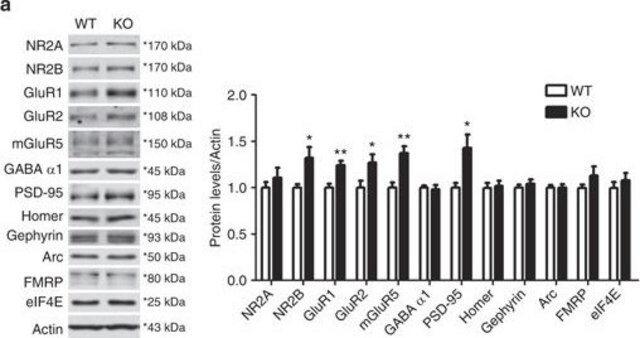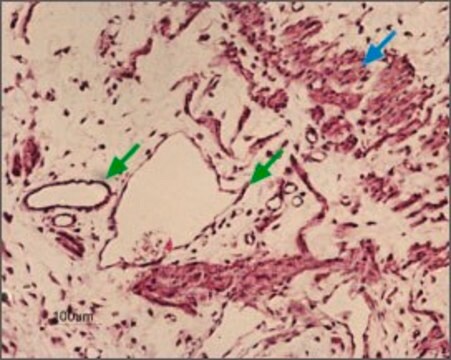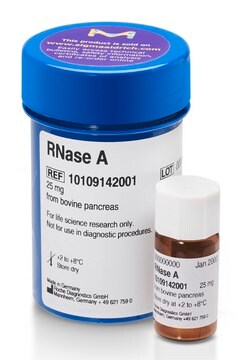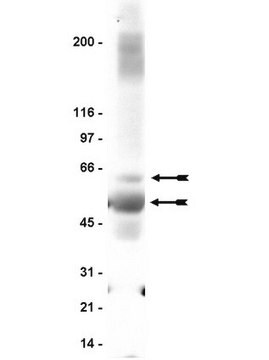G4291
Anti-GABAA Receptor (α3 subunit) antibody produced in rabbit
affinity isolated antibody, lyophilized powder
Sign Into View Organizational & Contract Pricing
All Photos(1)
About This Item
Recommended Products
biological source
rabbit
Quality Level
conjugate
unconjugated
antibody form
affinity isolated antibody
antibody product type
primary antibodies
clone
polyclonal
form
lyophilized powder
species reactivity
rat
technique(s)
immunohistochemistry: 1:200 using Rat brain frozen sections
western blot: 1:200-1:300 using Rat brain membranes
UniProt accession no.
shipped in
wet ice
storage temp.
−20°C
target post-translational modification
unmodified
Gene Information
human ... GABRA3(2556)
mouse ... Gabra3(14396)
rat ... Gabra3(24947)
Related Categories
General description
GABAA and GABAB receptors differ with regard to their ionic characteristics and pharmacological properties. The GABAA receptor is an ionotropic receptor that forms the GABA gated chloride channel and consists of several heterogeneous subunits with membrane recognition sites for benzodiazapenes.
Immunogen
peptide corresponding to amino acid residues 1-15 of human GABA(A) receptor α3 subunit. Identical in rat and mouse. Highly conserved (14/15 residues) in bovine.
Application
Anti-GABAA Receptor (α3 subunit) antibody produced in rabbit is suitable for immunohistochemistry at a working dilution of 1:200 using rat brain frozen sections and immunoblotting at 1:200-1:300 using rat brain membranes.
Biochem/physiol Actions
The inhibitory neurotransmitter GABA signals through two distinct types of pre- and postsynaptic receptors, GABAA and GABAB. Both GABA receptors can regulate depression of synaptic transmission and be involved in the inhibition controlling neuronal excitability. α3 is a subtype of GABAA receptor expressed selectively by serotonergic and GABAergic neurons. Serotonergic neurons express strong α3 immunoreactivity but, do not show any α1 immunoreactivity. On the contrary, GABAergic neurons express both α1 and α3 subunits.
Physical form
Lyophilized from phosphate buffered saline, pH 7.4, containing 1% bovine serum albumin, 5% sucrose and 0.025% sodium azide
Disclaimer
Unless otherwise stated in our catalog or other company documentation accompanying the product(s), our products are intended for research use only and are not to be used for any other purpose, which includes but is not limited to, unauthorized commercial uses, in vitro diagnostic uses, ex vivo or in vivo therapeutic uses or any type of consumption or application to humans or animals.
Not finding the right product?
Try our Product Selector Tool.
Storage Class Code
11 - Combustible Solids
WGK
WGK 2
Flash Point(F)
Not applicable
Flash Point(C)
Not applicable
Choose from one of the most recent versions:
Already Own This Product?
Find documentation for the products that you have recently purchased in the Document Library.
Eung-Kwon Pae et al.
International journal of developmental neuroscience : the official journal of the International Society for Developmental Neuroscience, 29(8), 819-826 (2011-10-04)
Perinatal hypoxia commonly causes brain injury in infants, but the time course and mechanisms underlying the preferential male injury are unclear. Intermittent hypoxia disturbs cerebellar γ-aminobutyric (GABA)-A receptor profiles during the perinatal period, possibly responding to transient excitatory processes associated
B Gao et al.
Neuroscience, 54(4), 881-892 (1993-06-01)
GABAA-receptors in the brain display a striking structural heterogeneity, which is based on a multiplicity of diverse subunits. The allocation of GABAA-receptor subtypes to identified neurons is essential for an analysis of the functional significance of receptor heterogeneity. Among GABA-receptive
Shubhash C Yadav et al.
Frontiers in molecular neuroscience, 12, 99-99 (2019-05-09)
In the mammalian retina, amacrine cells represent the most diverse cell class and are involved in the spatio-temporal processing of visual signals in the inner plexiform layer. They are connected to bipolar, other amacrine and ganglion cells, forming complex networks
Manmei Long et al.
Molecular cancer, 16(1), 167-167 (2017-10-29)
MicroRNAs (miRNAs) can act as oncogenes or tumor suppressors by controlling cell proliferation, differentiation, metastasis and apoptosis, and miRNA dysregulation is involved in the development of pancreatic cancer (PC). Our previous study demonstrated that Gabra3 plays critical roles in cancer
Keita Harada et al.
Journal of neurochemistry, 158(2), 153-168 (2021-03-12)
γ-Aminobutyric acid (GABA) is thought to play a paracrine role in adrenal medullary chromaffin (AMC) cells. Comparative physiological and immunocytochemical approaches were used to address the issue of how the paracrine function of GABA in AMC cells is established. GABAA
Our team of scientists has experience in all areas of research including Life Science, Material Science, Chemical Synthesis, Chromatography, Analytical and many others.
Contact Technical Service








